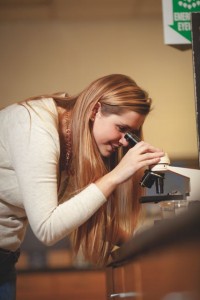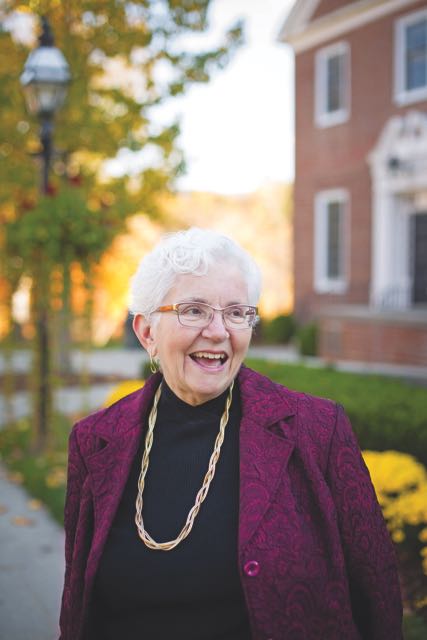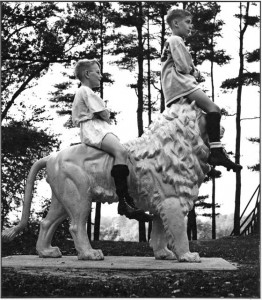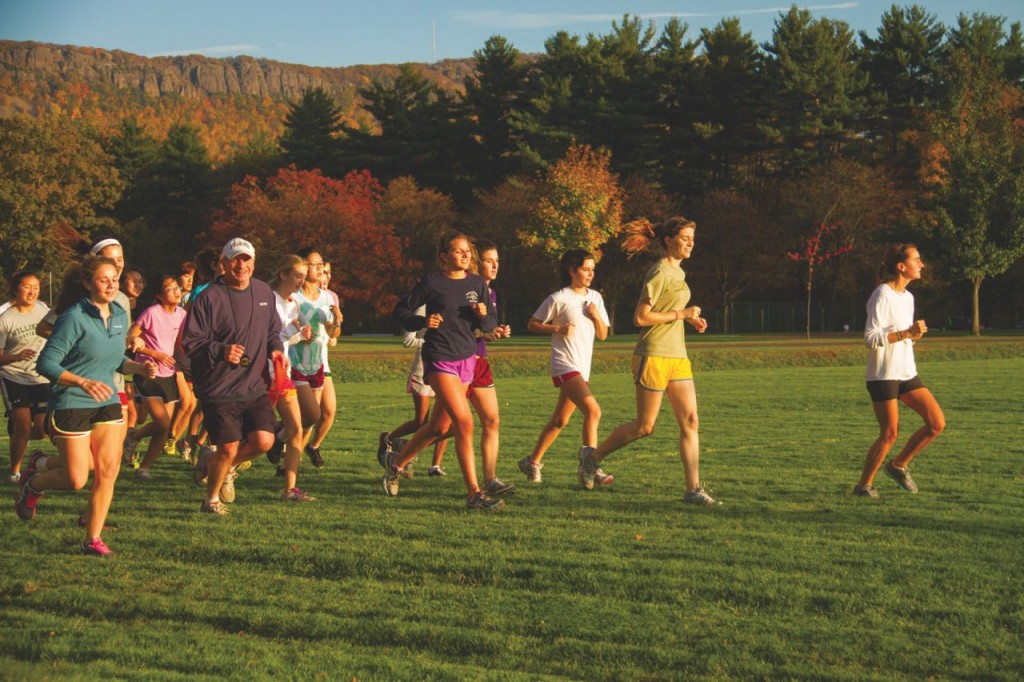Read the latest issue of the Bulletin here:
Read the latest issue of the Bulletin here:
I attended Williston for my senior year in 1951-52 and became involved with the ski team there just before the start of the 1951 Christmas vacation break. Mr. Babcock, one of the team coaches, had a tradition of taking a group of student-skiers to Stowe [Vermont] for a week of practice during the break and I talked my way into the group, based largely on my life-long passion for skiing and previous participation in a ski camp run by Dartmouth’s famed Olympic skier Warren Chivers at Mt. Moosilauke. Based on my performance at Stowe, Coach Babcock convinced me to drop off the basketball team and join the ski team.
We had daily practices at the Williston ski area, located a few miles out of town on the western slopes of Mt. Tom. The area was fairly close to a main road as I recall, and consisted of a 20 meter ski jump, and a sloping pasture area where there was a 500-foot rope tow with a small warming hut/motor at the base. The slalom courses and general skiing area were in the pasture. There was a adjacent downhill course that started up on Mt. Tom and for the majority of the run was nothing more than a fairly flat & winding pathway through the shrubs and trees until it took a sharp turn right into a wide open and steep 100 yard run that flattened out abruptly at the finish line. It was a very short course and all the fun was at the end. There was no ski lift of course, so skiers had to trudge through deep snow and trees up the course. Timing was done by sending off skiers from the start at regular minute intervals and a listing of racer’s names, so if skier A left at 3:10:00 and finished at 3:12:15, his time was calculated at 2 minutes and 15 seconds. Obviously this system was fraught with opportunities for mistakes and uncertainly!
How do you define yourself?
That was the simple—and surprisingly complex—question at the heart of the 2015 Diversity Symposium.
Keynote speaker and advocate Thomas Smith viewed the issue as a matter of triumph through adversity, while University of Massachusetts faculty member Dr. Kerrita Mayfield saw it as a problem of integrity.
In their student addresses, which began a day of workshops, Maranie Harris-Kuiper ’15, Verdi Degbey ’16, Anthony Leung ’15, and Cameron Stanley ’16 strove to answer the question through the multifaceted lenses of race, culture, sexual orientation, and religion.
Continue reading
Phil Stevens, Jr., is an anthropologist at the State University of New York at Buffalo. An excerpt of the following letter appeared in the fall Bulletin Vol 101, Number 2.
I was inspired by Victoria Brett’s article in the Winter Bulletin to set down some of my reflections on growing up on campus in the early 1950s. The life skills and breadth of knowledge I gained were extraordinary.
Phil and Sarah Stevens moved from New Haven in 1949, with four kids; in birth order: Phil, Jr. (called Flip), Peter, David, and Jonathan. Two more, Ruth and Timothy, would be born at Cooley-Dickinson Hospital in Northampton. My siblings will have somewhat different memories, but they share many of mine. For me, of course, “growing up on campus” meant also the status of Son of the Headmaster; and that experience was complex and fraught and must be a separate story! I will discuss here the opportunities the campus provided for a boy in the world.
I was 7 when we arrived and settled into The Homestead. That majestic building was really the face of the school, and its front rooms were to be maintained as a welcoming, comfortable, and stately space. Even the kitchen, with its fireplace with black iron kettle on a swinging hook, and Dutch oven, projected hospitality. To accommodate our expanding family, the floor above the kitchen and garage was subdivided into three bedrooms and a spacious playroom, where we spent many hours; and where Mrs. Donais’ Cub Scout Pack 22 met weekly! The basement was a delightful place for kids; with dark hidden spaces and a stairway to nowhere, a wood room and a coal room with chute, dust and cobwebs, the smell of age and neglect – it invited modification into a Halloween chamber of horrors, which we tried over a couple of seasons, charging skeptical friends 5c. for admission.
I should also say that in those days parents were far less fearful of letting their kids roam freely, which was a good thing, because the roles of Headmaster and Headmaster’s Wife were extremely demanding of time. [Mom always had live-in housekeepers of various ages and levels of tolerance, including a middle-aged Russian refugee (Displaced Person, or “DP” as that sad role was called then), a succession of female students at Northampton Commercial College, and a widow, Mrs. Marie Stillman, who lived with us until obliged to retire to an assisted-living facility. Part of those persons’ duties was to serve us suppers on the many evenings when Mom accompanied Dad at the Headmaster’s Table in the school dining hall – on the Main Street campus in the early years, then in Ford Hall.]
I attended Center St. School through the 4th grade, Junior School through the 8th, then left for Deerfield in the fall of 1955. I should note that the Main Street Campus, with its striking Old Gym Tower modeled after the tower in Siena’s town square, was extant for a few years, but was not part of my world.
 Emily Grussing ’15 was in AP Calculus when she learned the news: a scientific paper she researched and co-authored had just been accepted for publication.
Emily Grussing ’15 was in AP Calculus when she learned the news: a scientific paper she researched and co-authored had just been accepted for publication.
“It was the greatest thing. I didn’t expect to get published,” Ms. Grussing said. “It wasn’t something I even believed was possible.”
Ms. Grussing had spent the summer interning at Dartmouth College’s Geisel School of Medicine where she was charged with researching links between chemicals and cancers. To do so, Ms. Grussing learned coding basics, dove into online research, and analyzed and constructed scientific networks.
“I loved being in the environment of the lab,” Ms. Grussing said, adding, “I never had to do such self-learning in my life before.”
The resulting paper, which Ms. Grussing helped write, was accepted by the Pacific Symposium on Biocomputing, where it was presented on January 8. The paper will also be published on PubMed Central, an archive of scientific publications.
 On the lawn next to Hathaway House in 1973, shovel-wielding eighth graders dug into the dirt. The hole grew bigger, and impressively deep. From it, they pulled buried china doll heads, twisted pieces of metal, and hairbrushes.
On the lawn next to Hathaway House in 1973, shovel-wielding eighth graders dug into the dirt. The hole grew bigger, and impressively deep. From it, they pulled buried china doll heads, twisted pieces of metal, and hairbrushes.
They were exhuming a 20th century household dump. History teacher Karin O’Neil and colleague Thomas Smith were leading a bona fide archeological dig. What better way to teach history than to let kids unearth it?
Ms. O’Neil, Mr. Smith, and their students had organized an efficient setup. Some kids dug while others used sifters to gently shake away the soil from the artifacts. The dig itself lasted for several weeks, revealing other treasures—a salt-blazed stoneware crock, soles of shoes, pieces of Imari ceramic pottery that they glued back together—all clues to a different way of life, of people who lived on the same land before them. Researching the artifacts took longer, but ultimately the students proudly presented their findings to the Easthampton Historical Society.
“We were always looking for innovative ways to help students understand the way ‘history’ is made,” Ms. O’Neil says.
Paul Sigris ’78, was among those eighth grade excavators. He says his memories of the dig are “vivid.”
“It was a hands-on approach to teaching American history,” he says. “We weren’t watching an archeological dig, we were doing an archeological dig. There was a huge difference. It also meant that we got dirty.”
During her 33-year tenure at Williston Northampton, as both a teacher and an administrator, Ms. O’Neil had a talent for uncovering something miraculous just below the surface—from an old hairbrush, to a teacher’s innate ability to inspire a classroom of students. She took everything to the next level: first elevating how she taught history and then elevating how the school, collectively, approached the curriculum.
As the director of the Middle School, the academic dean, the dean of faculty, the assistant head, and finally, as associate head of school from 1990 to 2001, Ms. O’Neil was an historian who was also quietly, and rather cheerily, making history.
“To this day, I have an interest in archeology,” says Mr. Sigrist, an actor, who for 10 years directed an oral history project at the Ellis Island Immigration Museum. “Doing that dig was kind of a dream come true. Going down into that dirt seven feet down and pulling stuff out of the dirt, it was heaven. Certainly Ms. O’Neil fostered and cultivated that life-long interest in history, and I eventually pursued it as a career.”
 By Kevin Markey
By Kevin MarkeyOn a crisp morning in early November, Susanna White’s Upper School art students gather at the Reed Campus Center’s Grubbs Gallery. A recently mounted exhibit of landscape paintings by New England artist David Marshall — tumbling brooks, snowy hemlocks, summer hillsides — hangs on the soaring white walls, while the gallery’s large windows frame a view of the school’s pond, the maples outside bright with fall colors. It’s hard to imagine a more inspiring setting for a painting session.
Then the kids get down to work and, in place of the traditional pigments, brushes, and sketchpads, they open their backpacks and pull out Surface Pro tablets. For this morning’s assignment — explore Mr. Marshall’s plein air technique by sketching one of his oils — they’ll be working in Fresh Paint, a software app that mimics paint and brushes.
Welcome to the innovative world of Williston Northampton’s Curricular Technology Initiative (CTI), where every day students and teachers are finding new ways to apply digital tools.
Watch Microsoft’s video on the Surface at Williston Northampton.
Rolled out in stages over the course of the last year and a half, CTI is Williston Northampton’s name for its one-to-one technology program, through which the school issues a tablet computer to every student and faculty member. In addition to the actual tablets, the program includes the organizational and work-sharing software run by the devices, such as the notebook-sharing program OneNote, and the campus-wide wireless network that makes everything hum.
 By Victoria Brett
By Victoria BrettWhen she was in third grade, Kristina Conroy’s life changed dramatically. Suddenly, instead of quiet family dinners, Ms. Conroy was grabbing a plate at a dining commons and queuing up with a line of rowdy teenagers. Instead of a small backyard, an entire quad was her playground. Instead of one brother, Ms. Conroy had some 400 surrogate siblings to play with.
“I just remember getting there and feeling like I was surrounded by surrogate parents and surrogate siblings all the time,” said Ms. Conroy ’10, of her experience moving to a boarding school campus.
Such is the life of faculty and staff children, also lovingly called fac-brats, who grow up on campus, then often attend, and occasionally even return to live and work at a school like the one where they spent their childhood.
Ms. Conroy, whose family moved from California in 2000 so her father could be the athletic director and her mother a math teacher at Williston Northampton, her second boarding school home, was not like the older boarding students; she had no study hall, no check-in, and didn’t need to sign out of the dorm where she lived. Instead, she could roam the campus—under the supervision of some 200 adults, of course.
“It shaped me,” she said. “Everyone always says, ‘Why are you so good and comfortable talking to adults and strangers?’ I’ve grown up not just with my parents, but with other teachers and students.”
 “I was eager and ignorant,” laughs Academic Dean and girls cross country coach Greg Tuleja, as he remembers his first year at Williston Northampton.
“I was eager and ignorant,” laughs Academic Dean and girls cross country coach Greg Tuleja, as he remembers his first year at Williston Northampton.
Mr. Tuleja had never been on a prep school campus before he arrived at the school in 1983, fresh from graduate school at Rutgers University. A recreational runner, he had never coached before—but cross country seemed as good a fit as any that first year. It turned out to be much more than that for the new teacher. “I could tell from the beginning that the girls who ran cross country were determined and
disciplined,” he said.
There were only eight or so girls that first year. The second year only four girls ran. That meant that no matter how well those four runners did, the team had to forfeit every meet—a team needed five runners to qualify. And yet under Mr. Tuleja’s guidance, the team grew. By 1986, Williston Northampton had won its first New England Championship— the first of two under his leadership.
The team had 25 consecutive winning seasons, broken only by the fall of 2011, and has started a second streak with three straight since then. This fall, the team had 35 members, and Mr. Tuleja said other coaches regularly ask him how a school the size of Williston Northampton fields a team that large. He says he doesn’t have an answer.
His runners do, though.
“As a cross country coach, Mr. T. was a father to us. He led our team with a beautiful mixture of devotion to the sport and to his runners, and true selflessness,” wrote Adrienne Stolarz Mantegna ’94 in an email about her former coach. “He inspired us to be better every day. We wanted to do well, to be better, to win not just for us but always for him.”
Ms. Mantegna, who now teaches English at Williston Northampton, said Coach Tuleja never expressed disappointment in his runners.
Instead, he “would encourage, encourage, encourage.” Through Coach Tuleja, Ms. Mantegna said she learned how to run as a team, in a pack, working hard to keep pace with the stronger runners.
“Because of his compassionate leadership, it didn’t matter your level of skill, you were one of the family,” Ms. Mantegna said. “I had never run before I joined and still, 20+ years later, running is a part of my near-daily life because of how he taught me to do it, both physically and mentally.”
This year, Mr. Tuleja celebrated his 200th victory as a coach, and the thrill of coaching hasn’t lessened. “There’s something special about going down to the fields,” he said recently. “The girls may be dead tired and collapse after a race, and part of the reason they’re doing that is for me. They know what it means to me.”
Sophomore Emily Yeager added, “Mr. Tuleja makes running fun. From his jokes in practice, to a ‘Pitch Perfect’ team night, to the advice and
encouragement given on race day; Mr. Tuleja makes the cross-country experience unique. I have run for him for two years now, and I can honestly say that I feel honored to have him as a coach.”
What did Coach Tuleja mean to you? Share your memories and experiences in the comments section below.